Legends of Runeterra
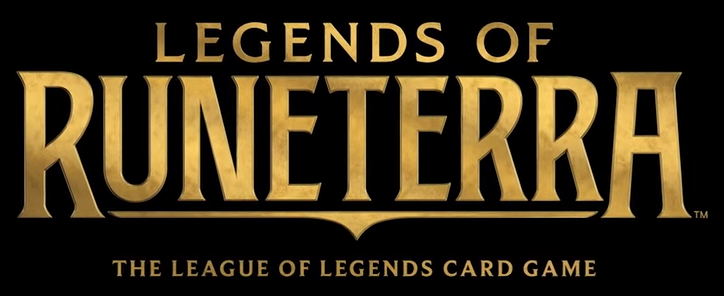
Intro
Earlier this year, I was looking for an alternative to Magic and Hearthstone. Both cost so much to get back into or have really excessive amounts of randomness built into the game. For the few hours I played Hearthstone earlier this year, it became apparent that often you draw a random card and each card you play also causes a random effect! When looking to get back into Magic, I played for a little bit, but after a while it just felt like gambling because the cost of entry into events requires real world money and you had to perform well enough just to play the game for a long time without spending a lot of money. At some point it just felt like the house always won. Then this video about Legends of Runeterra’s economy from The Professor, an MtG content creator, popped up on my youtube recommendations and I haven’t looked back. Legends of Runeterra(LoR) is the best player versus player digital card game I’ve played.
Where is the Fun
The game has the polish of a multi billion dollar game studio, Riot games (creators of League of Legends). The game is easy to pick up, put down, and feels really rewarding because of the Region level system. The region system allows you to work towards getting cards in your favorite region just by playing any the game. Games last about 10-20 minutes and matches take less than 30 seconds to connect. Riot has a very generous free to play strategy that has worked with League of Legends and has a great influence on the enjoyment of playing Runeterra. It’s so easy and cheap to build decks, you can have a variety of tier 1 decks without paying a single cent. The actual gameplay of having synchronous turns also keeps you more engaged since you never have more than 30 seconds between when it’s your turn to take a game action (as opposed to hearthstone where you might wait 3 minutes while your opponent goes to time).
Where is the frustration with these games
One of the biggest hurdles of card games requires learning all the rules, then learning the huge card pool, then learning all of the interactions between cards and constructing decks around those synergies. The tutorial/challenge system attempts to solve this by presenting players with puzzles to help explain mechanics and how they could be maximized. This gives new players experience with some of the cards and how they might synergize with each other. They even give you region points to get free cards at the end!
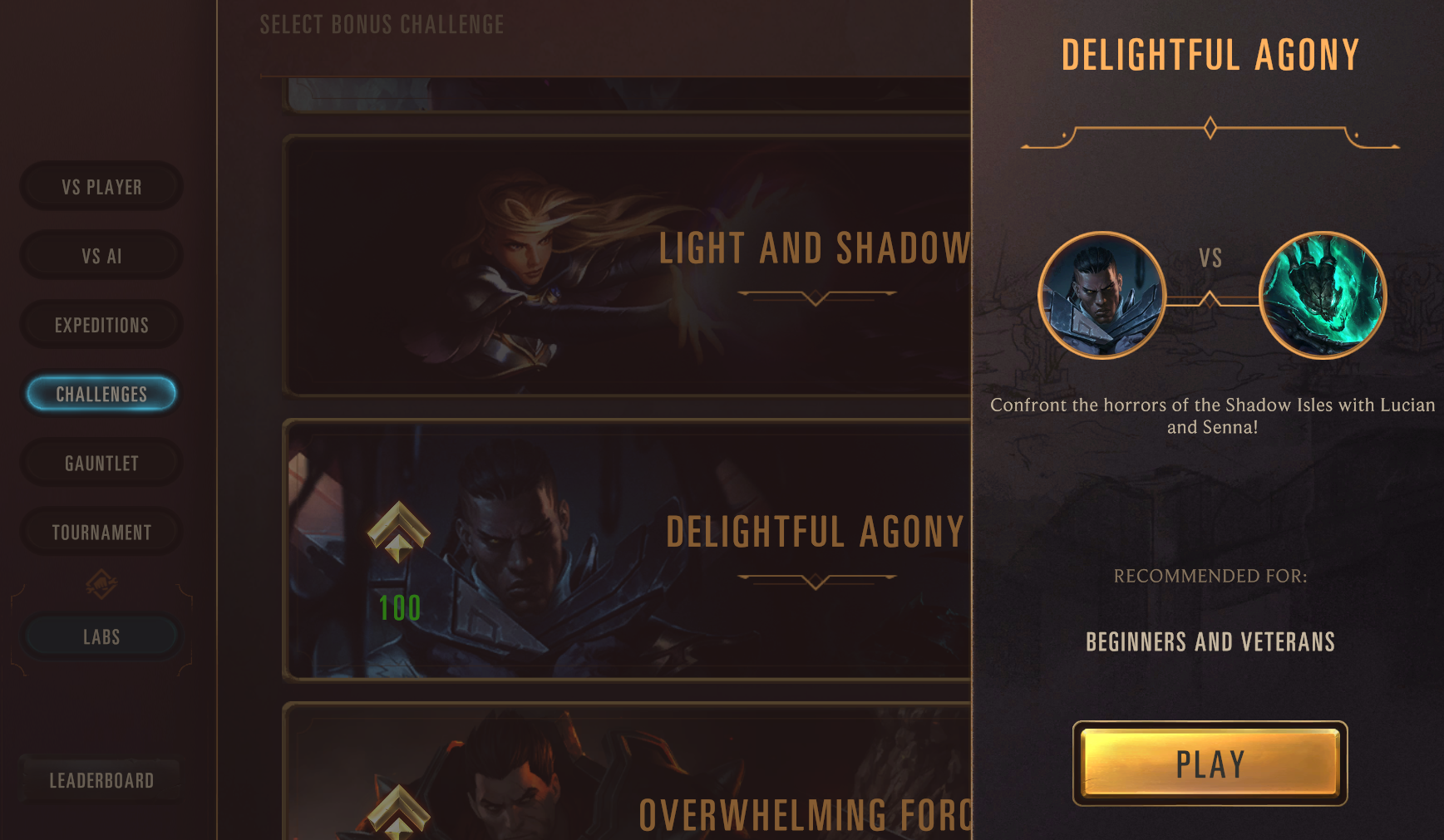
An example of choosing one of the many challenges
When it comes to learning new cards, the card inspection tool is fantastic and gives a quick reference at any point. You can see the card, any cards it references, and if there are keywords, what those keywords do.
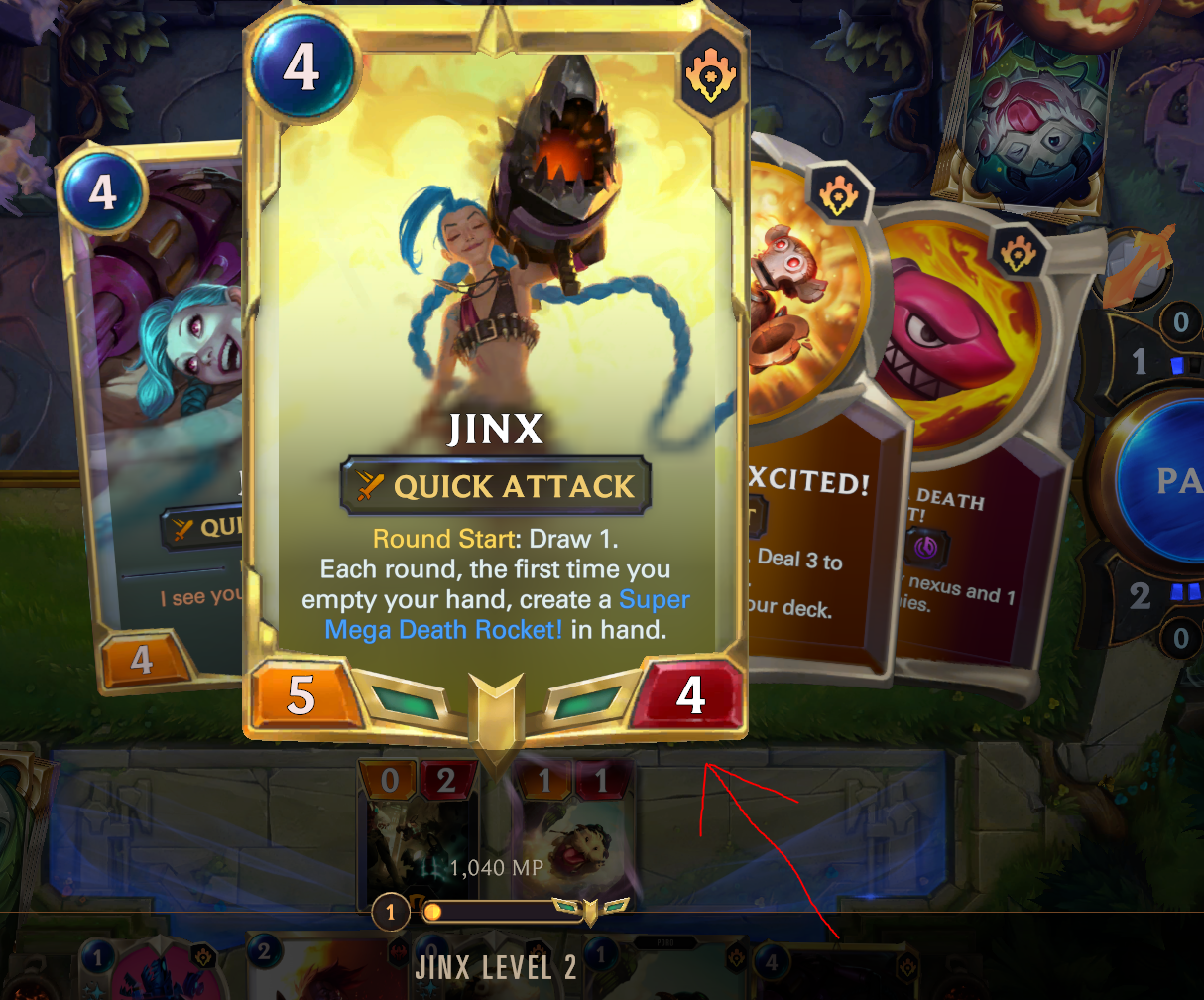
Inspecting a card
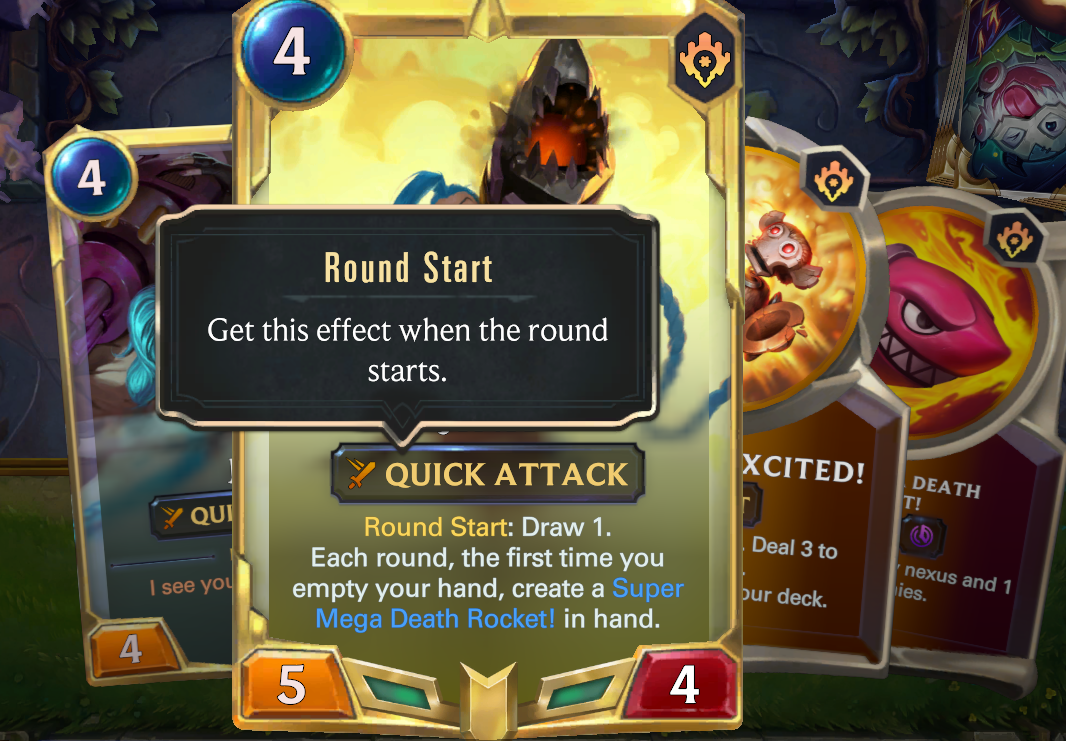
Inspecting a card’s keyword
Starting a collection can feel really daunting especially if coming into the game late. Riot has helped alleviate this by giving double Region points on the first 12 levels of each Region. This also helps you hit the cap on the weekly chest which can easily get you a tier 1 deck in the first week of playing, without spending a dime.
The biggest downsides to competitive card games for intermediate to advanced players come when the dominant strategy (or meta) propagates archetypes that are not of interest to you. For example, in Magic if the best deck is a lightning fast aggressive red deck, and you much prefer a slower blue black control deck, the meta is going to be extremely hostile to you, probably leading to you not enjoying playing for a season. While Runeterra isn’t immune to this problem, it has made monetization decisions that help balance this, I’ll talk about this more in the takeaways section.
Gameplay
I’m a fan of card games and I want to gush a bit about some of the great design decisions around the card game of Runeterra. I’m going to use Magic and Hearthstone as references since they’re the most played card games at the moment and are very similar to LoR.
Moment to Moment
The game focuses on a synchronous turn system with an alternating attack token. This means that A) each player gains all of their mana back each turn, B) each player alternates who has priority every game action, and C) each player alternates who takes priority and can attack each turn. Because of A and B, each player never spends more than a few seconds without taking a game action, giving your mind something to think about and keeping you engaged in the game the entire time*. C slows down aggro decks to stop from winning until at earliest turn 4 or 5, giving the defending player 10 mana to respond whether they are attacking first or not. In magic or hearthstone, a defending deck may have 6 or 10 mana to respond whether on the play or on the draw. That’s a big difference that checks aggressive strategies and prevents uninteractive games. The synchronous turns also allow for interesting plays where a player can bait an opponent into spending all of their mana, then play a trump card, stopping the opponent’s ability to respond. It feels a bit like Euchre or the more modern Gwent in that respect.
Legends of Runeterra also has a simple combat system. You may have up to 6 units in combat (magic can have unlimited and hearthstone has 7). There can be at most 1 blocking creature per attacker and there is no priority if no blocks are declared (this minimizes the impact of combat trick based combo decks). There is also a quality of life feature called the Oracle Eye which shows the impact of combat allowing you to quickly see how a combat would play out without having to do arithmetic only to realize you blocked incorrectly and died. Having the interaction of choosing blockers in combat as well as limiting the field really helps in keeping the board clean and manageable.
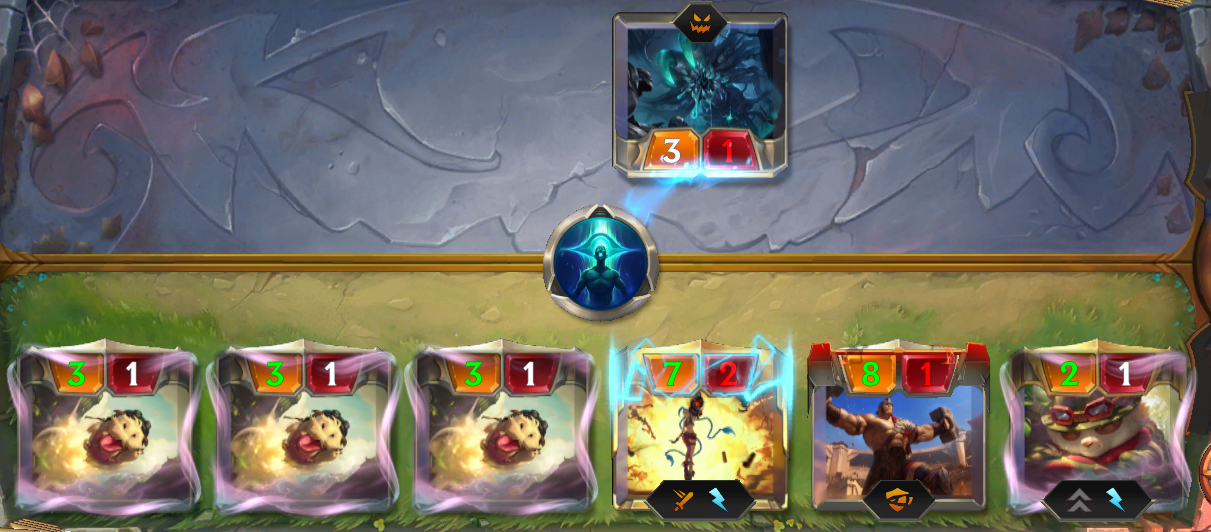
The last core feature of LoR is the mana system. Mana systems are very important with how card games pace out each match. Without mana costs, every deck would just have huge creatures. With inconsistent mana sources, like land in magic, you end up in situations where one player just doesn’t get to play the game because of luck. LoR has a similar system to hearthstone where each turn the player refills all of their mana and the maximum is increased by one each turn. One issue with this is that defensive decks often don’t use 1 or 2 mana cards since they have such a low impact on the game, so 3 mana cards have to have a really big impact on the board. It also benefits aggressive decks by making them very consistent. LoR has a clever solution called spell mana where up to 3 unspent mana you have at the end of a turn goes into a bank where you can spend it in a later turn but only on spells. This means that a defensive deck can play up to 6 mana on turn 3 (if they banked mana on the first 3 turns). This does cause LoR to cost defensive spells at around 1 or 2 mana above their magic/hearthstone counterparts but it still feels like there’s a lot you can play with on a turn by turn basis with this bank system.
Deck Construction
Deck construction and restrictions play a big part in constructed formats for card games like LoR. Hearthstone has cards exclusive for each class with a pool of cards that’s shared by all of them. Magic has no restrictions other than the color cost of the cards (it’s hard to play a blue spell when all you have in your deck are red and green mana sources). LoR takes a champion centric approach to deck construction. Currently each deck may have up to 6 champions and each card may only appear 3 times in your 40 card deck. In addition, you can only have cards from 2 of the 9 (soon to be 10) regions.
What this boils down to is decks that are primarily focused around enabling the powers of champion cards during a match, this creates a subgoal within each match (which can lead to engaging gameplay and interesting choices). This also gives you the idea of what type of deck an opponent is playing as the champions and regions are signalled when beginning a match. So for example if an opponent is playing 2 aggressive champions, you can tailor your game plan and mulligan strategy around trying to survive the first few turns as opposed to looking for cards that give long term benefits.
These deck restrictions lead to each region having a variety of playstyles associated with them. For example, there are currently 2 top tier decks that both come from the same region combination but have drastically different play styles because of the champions involved. Those decks are Jinx/Draven discard aggro and Ezreal/Draven slow burn.
With new expansions come new cards and LoR has gone with a horizontal scaling system. Each set adds a new region (until a total of 10 regions) and 4-15 cards for the existing regions. So far the plans are 2 set releases per year with 2 expansions on each set released soon after. This leads to 6+ (there have been other card releases outside of this schedule that have also occurred) total card releases along with huge balance patches to shake up the metagame every few months.
Finally, there are no sideboards at all. Instead, tournament play requires 3 different decks and you play best of 3 games in a single match. Each match begins by banning one of your opponents 3 decks. When you win with a deck, you must then win another game with your other unbanned deck. There are 2 big benefits to this plan, the first is that it limits the dominant strategy problem where there is one deck that is way better than all of the others, players can just ban that deck or choose their roster of decks to counter that deck. Second is that it allows players to play a variety of decks rather than getting ultra specialized in one single deck. Unfortunately, at the moment ladder matches do not mirror this playstyle (they are best of 1 matches) which can lead you to playing against the dominant strategy many times in a row.
Labs
Similar to Hearthstone’s ‘brawl’ mode, there is an experimental mode called labs, which allows for different rules to be played. LoR introduced a mode in Labs called Lab of Legends which is a roguelike player versus ai (enemy) mode similar to Slay the Spire or Monster Train. This game mode is incredibly popular and quite enjoyable to play. At the time of writing, you begin by picking a champion and get a deck associated with enabling that champion. You then play 9 enemies and after each enemy you get cards with power ups and deck wide power ups. This allows players to draft wacky strategies and create absurd combos that would never occur in competitive play. In addition, you gain region experience allowing you to get cards for constructed play. The replayability of this mode comes down to the huge variety of champions you can choose from.
This format was just an experiment at first, but has blossomed into one of the main game modes in LoR to the point where they have invested significant resources into developing it. There is a new version with RPG elements that is great, and really captures the variety of a slay the spire with a smaller champion pool to start with, but greater delta in strategies to build around. It’s really awesome to see an off the cuff idea like this blossom into something so successful among the community.
Score/Visuals/Story
While there is only one song that really plays, it’s subtle but relaxing and I’ve caught myself humming it when I’m not playing. While there is no real story in LoR, there is quite a bit of lore associated with the League of Legends universe that explains more about each region and champions. The art for each card is beautiful, timeless, and cute. It’s oddly easy to get attached to each champion simply based on the voice interactions that occur when you play champions, level them, or play cards associated with them. It’s a really subtle interaction but is a really polished touch when you come across a new one and it makes you laugh or smile. When champions level up in a game they also play a small animation for both players. These can be cool but also a little long such as the Shurima Feature Length Film.
Takeaways
The biggest takeaway I have from Legends of Runeterra is how well it strikes a balance around free to play power and monetization elements in a modern collectible card game. It feels like every game nowadays has some form of microtransaction that is either pay for power, variety, or cosmetics. One of the key requirements for online competitive games is a large fan base and free to play is always going to be the biggest decider on that to pull in new players. The problem comes when microtransactions become the only source of income for a game and shady business practices come into play such as gacha mechanics to distribute power.
Riot has decided that with Legends of Runeterra they would opt for a model where you could generously earn plenty of cards just by playing the game, and there would be a cap on how expensive a deck could be. Currently the cap is 55 dollars (6 champion cards and 34 epic cards), but most tier 1 decks cost 25 dollars if you have exactly 0 cards to begin with. Most of the time however, the costs are almost completely subsidized by wildcards earned while playing the game. This is roughly the same cost as a pauper (all commons) deck in Magic the Gathering. Because the cost of cards is so low, Riot can be very liberal with balance patches. If one deck needs to be adjusted, players can easily and cheaply swap to a different deck.
So how does Legends of Runeterra make money? While they’re generous with cards, they’re stingy with cosmetics. Emotes, game boards, guardians, card backs, alternate art champions, and prismatic card borders are all cosmetics that are either very difficult to acquire or come straight from the cash store.
After playing for a few months, I’ve felt as if any deck is attainable and if I wanted more variety quickly, I could easily see myself spending money. I’ve definitely spent more on Magic, because there was a strong social connection to the game where you had to pay to enter into tournaments (local and regional). With Magic I’ve never owned a digital tier 1 deck and have never owned all of a tier 1 standard deck (I’ve always had to borrow some of the more expensive cards or entire decks). I’ve always been a little uncomfortable spending so much money on singles in magic since it always felt a little bit like gambling and tournaments started to feel like work in order to win back your entry fee. The only money I spent in hearthstone was for the campaign modes. I would do the same here if Riot chose to go that route.
I think overall LoR gives the experience of playing a digital competitive card game without the enormous financial costs to enter into the space with more popular games.
Conclusion
Overall, I think Legends of Runeterra is a fantastic card game with a great monetization/free to play system. I foresee myself playing plenty of Legends of Runeterra this year and in the years to come.
*This was a common problem in magic and hearthstone where you would spend all of your mana, pass the turn and just wait for a minute or more while your opponent decides what to do.
